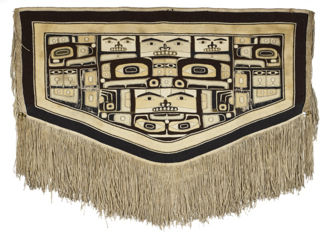Chilkat blanket: Difference between revisions
No edit summary |
No edit summary |
||
| Line 4: | Line 4: | ||
The style of blanket, woven on a three-sided loom with a long fringe, is attributed to the Tsimshian people, though the name "Chilkat" refers to another tribe which lived in the area around the Chilkat River. Chilkat blankets can take a year to weave, proceeding along vertical sections with complex curvilinear forms constructed within the weave itself. The threads were originally died in yellow, black, and blue, contrasting with the buff color of the undyed strands. | The style of blanket, woven on a three-sided loom with a long fringe, is attributed to the Tsimshian people, though the name "Chilkat" refers to another tribe which lived in the area around the Chilkat River. Chilkat blankets can take a year to weave, proceeding along vertical sections with complex curvilinear forms constructed within the weave itself. The threads were originally died in yellow, black, and blue, contrasting with the buff color of the undyed strands. | ||
The blanket was | The blanket was one of a large number of Native objects acquired by collector Axel Rasmussen, who had served as a superintendent of schools in Skagway, Alaska. The collection was purchased by the Portland Art Museum in Portland, Oregon in [[1948]] through Los Angeles, California art dealer Earl Stendahl. The Birmingham Museum of Art purchased the blanket along with several other objects from that collection in [[1956]]. | ||
{{stub}} | {{stub}} | ||
Revision as of 09:45, 21 June 2021
Chilkat blanket is a ceremonial blanket woven in the 19th century by members of the Tlingit tribe near Ketchikan, Alaska that has been part of the collection of the Birmingham Museum of Art since 1956. The 65 3/4" wide by 35 1/2" long blanket is woven of goat wool and soft yellow cedar bark, likely as a potlatch gift to a chief or high-ranking male, to be worn over the shoulders during a ceremony. The symmetrical design, depicting an octopus, is made up of family crests depicting animal heads in a graphic, abstracted style.
The style of blanket, woven on a three-sided loom with a long fringe, is attributed to the Tsimshian people, though the name "Chilkat" refers to another tribe which lived in the area around the Chilkat River. Chilkat blankets can take a year to weave, proceeding along vertical sections with complex curvilinear forms constructed within the weave itself. The threads were originally died in yellow, black, and blue, contrasting with the buff color of the undyed strands.
The blanket was one of a large number of Native objects acquired by collector Axel Rasmussen, who had served as a superintendent of schools in Skagway, Alaska. The collection was purchased by the Portland Art Museum in Portland, Oregon in 1948 through Los Angeles, California art dealer Earl Stendahl. The Birmingham Museum of Art purchased the blanket along with several other objects from that collection in 1956.
References
- Birmingham Museum of Art (1984) Handbook of the Collection. Birmingham:Birmingham Museum of Art/Birmingham Publishing Company ISBN 0931394090
- Chilkat Blanket, Tlingit people, 19th century at artsbma.org
